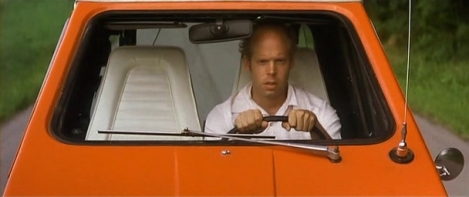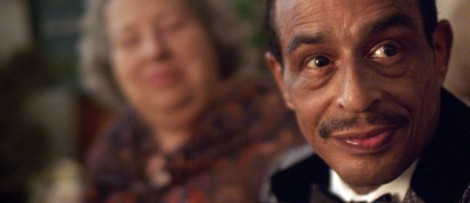
Todd Rohal is an award-winning writer and filmmaker. His 2006 debut feature, The Guatemalan Handshake, won the Grand Jury Prize at the Slamdance Film Festival. His second feature, The Catechism Cataclysm, had its World Premiere at the 2011 Sundance Film Festival. In 2009, he participated in the Sundance Screenwriters Lab. Most recently, his short film Rat Pack Rat was awarded the Special Jury Award for Unique Vision at Sundance 2014, where it had its World Premiere. Rat Pat Rack has also been chosen as an Official Selection of the 2014 South by Southwest Film Festival (SXSW.) Todd Rohal spoke with Sean Malin of CineMalin: Film Commentary about a career in dark comedy, the value of YouTube for short films, and what exactly constitutes a “unique vision.” This interview has been transcribed, edited, and compressed from audio for publication.
*****
Sean Malin: At the moment, many of the most significant filmmakers in the independent scene are coming from Austin [where Mr. Rohal is based.] This term has emerged around the group, which includes you, Andrew Bujalski, Kat Candler, and several others – and I don’t mean to be at all derogatory – called the, “Austin Mafia.” Have you heard this?
Todd Rohal: Yeah, someone else mentioned this at the Sundance Film Festival [in 2014], and I just thought, “Isn’t there another term for it, like La Familia?”
SM: I could refer to you as the “Corleones of Austin.” But when I interviewed another Austin-based filmmaker last year, Yen Tan [who designed the title and credits sequence for Rat Pack Rat], he described it as more like several concentric circles of filmmaker-friends who work with one another based on loyalty and trust than anything.
TR: That’s kind of the reason I came down to Austin, actually, because so many people I knew were moving here. For example, my friend [Michael] Tully [director of 2014 Sundance Official Selection Ping Pong Summer] moved here when his wife, Holly [Herrick], got a job with the Austin Film Society. And everyone here knows each other’s movies – it seems like when you’re here, you just go to see movies and you meet the other people who have made them. There are a lot of coincidences because this is a very small town…
SM: I read that you lived and worked for a bit in Brooklyn, New York at one point.
TR: I managed to work in New York but I never liked it – I always liked coming to Austin. Every time I came to visit, I’d be happy, and I loved the people.
SM: It seems to be getting ever-larger if the presence of Austin-based and AFS-supported work at Sundance is any indication. And as it grows, the filmmakers’ budgets grow too – I’m just thinking of your debut in 2006, The Guatemalan Handshake, versus your third feature, Nature Calls (2012.) That’s a pretty huge step forward.


TR: Well, budgetarily perhaps, though narratively Nature Calls was more like eighteen steps backwards. *Laughs* I see what you’re saying, though, like with the Zellner Brothers’ [2014 Sundance Official Selection] film Kumiko, the Treasure Hunter – now there’s a good example of what happens when you give someone with a very specific and true vision money to let them make their movie. They went and made something unlike anything at Sundance this year.
SM: The Sundance folks seemed to agree that you did the same with Rat Pack Rat, which they gave a Special Jury Award for Unique Vision. You made a decision to partner with them during the festival to release your film on their YouTube channel with fourteen other shorts. How was that as a platform for the short?
TR: That was perfect for this film because I didn’t want anyone else to own any part of it. I didn’t want to deal with anyone’s ideas about where it should go or how to sell it. Rat Pack Rat is a specific type of film – I wasn’t interested in making it based on committee decisions. I asked some friends for notes on it right before we went out and shot it, but I really did not want another person’s take on what we should do with the movie. After my last experience, I’m so allergic to those ideas, so having made something where all I wanted was to show it to people at Sundance – and if I had had to burn the whole thing afterward, I would have. Luckily, we’re going to have some life beyond that – the goal was definitely accomplished. For that purpose, the YouTube channel was great.
SM: What was the process of deciding to put your film online amidst the Internet trolls? There was only a select group of shorts on the channel, right?
TR: Sundance has been doing this for a couple years where they choose fifteen or so; Kat Candler did that last year with her short, Black Metal (2013,) and I just thought it was a great idea: here’s this free thing just for you! But I disabled the comments immediately…I hate the Internet *laughs*.
SM: Like Kat Candler’s feature Hellion (2014,) which played at Sundance this year, your film has some direct support from the Austin Film Society, and some indirect support in the form of those aforementioned loyalties. How much of the making of this short required asking for favors?
TR: Everyone on the crew, of course, though we paid when we could. When you’re doing a short, asking for favors is pretty much a given. Everyone in the credits was basically providing a favor. We made [the film] in just three days here in Austin. Mike Tully was our Best Boy; [filmmaker] Clay Liford was my producer (and gaffer.)

SM: Some of those credits are pretty unique. “Lynn Shelton – slide whistle repair. David Wingo – crying man hiding in the corner.”
TR: My producer, Zack Carlson, made those up. Those are for supporters of the Kickstarter fund.
SM: You mentioned on the Kickstarter page that you wrote this story for the three actors who appear in the film: Margie Beegle, Eddie Rouse, and Steve Little. Was there ever a point – considering Mr. Little’s commitments to Eastbound & Down or Quentin Dupieux’s Wrong Cops (2013) – where you felt you needed to have understudies waiting in the wings to play any of these characters?
TR: Absolutely not. Eddie looks a lot like Sammy Davis Jr. and he asked me if I could write something around that for him. However, when he read the script he immediately told me he wouldn’t do it and it was disgusting, I think because he didn’t realize we were going to be playing the whole thing straight. It’s hard to tell the tone of something just by reading the script, you know? As weird as this movie is, when he got that [we’d be doing it straight,] he started to understand the deep humanity of the character [a Craigslisted Sammy Davis Jr. impersonator] and he called me at three in the morning to tell me he wanted to do it. Had he not wanted to, as in the three months before that call, I thought it just wouldn’t get made and I was going to move on to something else.
SM: You’ve spoken a bit about the difficulty of making your previous film. Did the making of Rat Pack Rat help you to repair some of the pain of the experience with Nature Calls?
TR: Yes, definitely, it was meant to be a bridge for me towards a kind of purer story that I wanted to tell. Everyone on the shoot was aware beforehand that my attitude was, “I am MAKING this. If we fail at it, or if it sucks, or if it’s not funny, I want that to be 100% my fault.” This is how I’ve worked in the past, too; I made The Catechism Cataclysm in 2011 while I was still trying to get the boy-scout script made. That movie was roughly about the process of hearing, “We really like who you are! But can you change what you’re doing?” In the case of Catechism, it’s about a priest who loses his faith and wonders why he’s on the life path he’s on. But it was just as much about me as a filmmaker asking why I even do this if producers who say they “like” me just secretly want me to do something else for them.
SM: So what did you get out of making Rat Pack Rat?
TR: I think comedy and film is like any kind of art form: you have this picture in your head that makes you feel a certain way. You can see it becoming real and tangible [as you make the movie.] And then when it’s finished you show it to someone else and see if that feeling has translated to them. It’s an incredible thing. Making Rat Pack Rat is not about the screenings and it’s not about the awards – I’m not an awards guy, though the Special Jury Award is incredibly flattering – but it’s about that one moment where I see This Thing that I’ve turned into That Thing, usually in the edit, and now you can see it. It’s become translatable.
*****
Watch The Guatemalan Handshake here.
Watch Nature Calls here.


Pingback: Don Verdean (2015) Sundance Review | CineMalin: Film Commentary and Criticism·